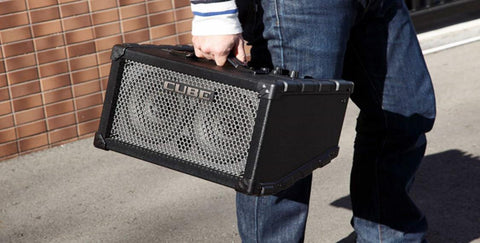As a musician, one of the greatest joys is sharing your music with others. Outdoor performances offer a unique experience that can resonate with people in a special way. However, the question remains: how do you power your guitar amplifier for an outdoor gig? In this article, we’ll explore the various solutions available to ensure your music can be heard outdoors.
Before Choosing the Battery- Count How Much Power You Need

Here’s a question from reddit, let’s take this for example.
To choose the right battery and inverter for 50W and 60W guitar amps, you first need to calculate the power you need.
For example, if you want to power both amps at the same time, you'll need a total power output of 50W + 60W = 110W. However, it's important to note that guitar amps often draw more power during peak performance or when using certain effects, so it's a good idea to choose an inverter with a wattage capacity that is higher than your estimated power output.
Next, you'll need to choose a battery that can supply the required power for your inverter. You need a battery with enough capacity to power the inverter for the amount of time you require. The capacity of the battery is measured in ampere-hours (Ah). You can use this formula to calculate how many ampere-hours you need:
(C) capacity (in Ah) = (P) power (in W) x (T) time (in hours) / (V) voltage (in V)
For example, if you want to power your amps for three hours using an inverter with a power output of 110W and a battery voltage of 12V, the required battery capacity would be:
(C) = (P) x (T) / (V) = 110W x 3h / 12V = 27.5Ah
So, you would need a battery with a minimum capacity of 27.5Ah to power your amps for three hours. However, as with the inverter, it's a good idea to choose a battery with a higher capacity to ensure you have plenty of power and to avoid draining the battery too quickly.
Keep in mind that you need to choose a battery that is designed for deep-cycle use, as this type of battery is designed to withstand repeated deep discharge and recharge cycles, which is common when using batteries to power inverters.
Way 1: Use a Car Battery with Inventor
If you're looking to jam on the go or perform outside for a while, using a car battery to power your guitar amplifier can be a feasible and cost-effective solution. To achieve this, you will need to convert the DC power from your car battery to AC power, which is similar to the power supply from your wall.
Most car batteries can provide sufficient power to run 50-100 watt amplifiers, although continuous draining can quickly deplete the battery. Despite this, setting up your guitar amp to run off a car battery is not a complex or expensive process.

When using the car battery, you need an inverter to convert the DC power from your car battery to AC power required for your guitar amp. Inverters come in various sizes and capacities, so it's essential to ensure that the inverter you choose can handle the wattage requirements of your amplifier.
Inverters do require a small amount of power to run, so it's important to consider the power consumption of the inverter and factor that into your calculations when determining how long your car battery will last during use.

It’s also recommended to use a pure sine wave inverter, which produces a clean and stable power output similar to that of the household electrical supply. This helps to avoid any unwanted noise or damage to your guitar amp during use.
However, it's important to note that car batteries are not specifically designed for this type of usage, and they may not provide a consistent level of power over an extended period of time. Also, continuously discharging a car battery to power a guitar amp may shorten the battery's lifespan and eventually damage it.
If you plan on using a car battery to power a guitar amp, it's important to ensure that the battery is fully charged before use, and to monitor the battery's voltage levels to avoid over-discharging it. It’s also recommended to use a battery isolator or voltage regulator to protect the battery and your guitar amp from electrical damage.
For a more reliable and suitable power solution for guitar amps, you may consider using a deep cycle battery specifically designed for this purpose which can provide a consistent level of power over an extended period of time.
Way 2: Use Deep Cycle Battery with Inventor
A better option than using a car battery is to invest in a deep cycle battery designed specifically for powering your guitar amp. Deep cycle batteries are designed to withstand repeated deep discharges and recharges, making them ideal for use with inverters.
When it comes to choosing a battery for powering your guitar amplifier, two popular options are lead acid and LiFePO4 batteries.
1. Lead-Acid Battery
Lead acid batteries are the traditional choice for deep cycle use and can provide a good amount of power for your guitar amplifier. However, they are known to discharge quickly when used at high power and they also require regular maintenance, such as checking the water levels.
Here’s a comment when they after using the cheap lead acid battery. “After lugging around a lead acid battery for an hour worth of juice becomes a pain when you can get 5 hours out of an amp that weighs 51lbs and sounds better.”

Although lead acid batteries are widely used in various settings, they also have some drawbacks. Here are some common drawbacks of lead acid batteries:
- Heavy weight: While the weight of the battery may not be a significant concern in this context, it may be an issue if the battery needs to be moved around frequently or transported to different locations.
- Limited lifespan: If the battery is being used frequently, its limited lifespan(300-500 life cycles, can be used around 3 years) may become a concern. Over time, the battery may lose its capacity and require replacement or regular maintenance.
- Slow charging time: Depending on the battery capacity and the power demands of the guitar amplifier, the slow charging time of lead acid batteries may be a significant drawback. If the battery is being used frequently, it may not have enough time to fully charge between uses.
- High self-discharge rate: If the guitar amp is not being used frequently, the high self-discharge rate of lead acid batteries may become a concern, as the battery may lose its charge even when not in use. This could cause problems if the battery needs to be ready for use at a moment's notice.
- Environmental concerns: If the battery needs to be replaced, it's important to dispose of it properly due to the toxic lead and sulfuric acid they contain. Improper disposal can cause harm to the environment.
When used frequently, they may require replacement sooner compared to LiFePO4 batteries.
2. Lithium Iron Phosphate (LiFePO4) Batteries
LiFePO4 batteries, on the other hand, are a newer option that is quickly becoming popular for powering guitar amps. They offer a number of benefits over lead acid batteries, such as longer lifetimes, faster charging times, and lighter weights. LiFePO4 batteries also have a higher discharge rate, which makes them ideal for powering high-power amplifiers.

Here’s the advantages of choosing LiFePO4 batteries for busking:
- High energy density: LiFePO4 batteries have a high energy density, which means they can store a lot of energy in a relatively small unit. This makes them more compact and lightweight than other battery types, making them easier to transport and use for busking. For example, a LiTime 12V 50Ah LiFePO4 battery weights only 11.57 lbs, while the lead acid battery with the same capacity weights 63.9 lbs.
- Long lifespan: LiFePO4 batteries have a longer lifespan than other battery types,which means they will last longer before needing to be replaced. This can save you money in the long run and reduce your environmental impact. Generally, LiFePO4 batteries can last for up to 2000 cycles or more with proper care and maintenance. However, LiTime LiFePO4 batteries can last for up to 4000-15000 cycles, which can be used up to 10 years.
- Fast charging: LiFePO4 batteries can be charged quickly, which means you can recharge your batteries between performances without spending a lot of time waiting for them to charge.
- High discharge rate: LiFePO4 batteries can provide high discharge rates, which means they can deliver a lot of power quickly, making them ideal for use in high-power devices like amplifiers.
- No maintenance: LiFePO4 batteries require little to no maintenance, which means you can focus on your performance without worrying about maintaining your batteries.

Overall, LiFePO4 batteries offer a reliable and efficient power source for busking and other portable power applications.
A 12V 50AH LiFePO4 (Lithium Iron Phosphate) battery would be suitable for powering a 50W or 60W guitar amplifier.
LiFePO4 batteries have a high energy density, can provide high discharge rates, and have a longer lifespan than traditional lead acid batteries. They are also lightweight and have a low self-discharge rate, making them attractive options for portable power applications.
A LiTime 12V 100AH LiFePO4 battery would provide more energy storage capacity compared to a 12V 50AH LiFePO4 battery, which means it can power a guitar amplifier for a longer duration before needing to be recharged. However, the increased capacity comes with a trade-off as the larger 100AH battery will weigh more with the weight at 24.25lbs.
Ultimately, the decision on which battery to choose comes down to the specific requirements for your application. If you need the amplifier to run for extended periods of time and weight is not a primary concern, then the 12V 100AH LiFePO4 battery would be a better choice. On the other hand, if the amplifier is only being used for short periods of time or needs to be frequently moved, the 12V 50AH LiFePO4 battery may be a more practical option due to its lighter weight.
Final Thoughts
To sum up, there are several ways to power your guitar amp for an outdoor performance.
Using a car battery with an inverter can be a cost-effective solution, but it's important to monitor the battery's voltage levels and use a battery isolator or voltage regulator to protect your amp and battery from electrical damage.
A better option is to use a deep cycle battery specifically designed for the purpose, such as a LiFePO4 battery, which offers a high energy density, long lifespan, fast charging, and a higher discharge rate than traditional lead acid batteries.
------------------------------------------------------------------------------------------------------
You may also like
<<< Everything About Battery Terminal Corrosion And How LiFePO4 Batteries Can Help Prevent It
<<< Unlock More Power - Top Tips For Expanding Your Battery Bank That’s Already In Use

![[Full Guide] How to Check the Charge in Your Marine Battery](http://www.litime.com/cdn/shop/articles/How_to_Check_the_Charge_in_Your_Marine_Battery_165x.jpg?v=1721817768)









